
Finkenzeller K.RFID handbook.2003
.pdf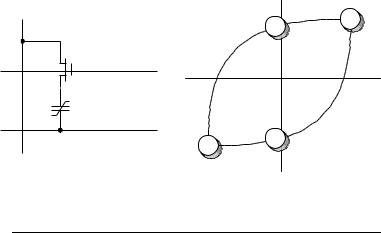
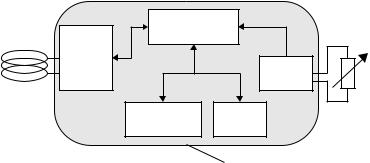
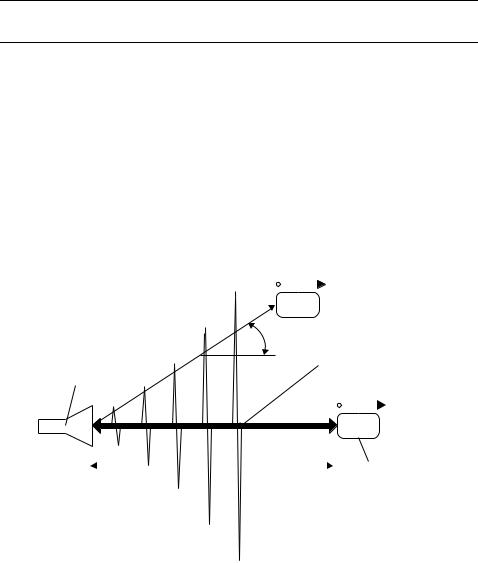
304 10 THE ARCHITECTURE OF ELECTRONIC DATA CARRIERS
Table 10.4 Sensors that can be used in passive and active transponders (mm = micromechanic)
Sensor |
|
Integratable |
|
Passive |
|
Active |
Single chip |
||
|
|
|
|
transponder |
transponder |
transponder |
|||
|
|
|
|
|
|
|
|
|
|
Temperature |
|
Yes |
|
Yes |
|
|
Yes |
Yes |
|
Moisture |
|
Yes |
|
Yes |
|
|
Yes |
Yes |
|
Pressure |
|
mm |
|
Yes |
|
|
Yes |
Yes |
|
Shock |
|
mm |
|
Yes |
|
|
Yes |
|
|
Acceleration |
|
mm |
|
|
|
|
Yes |
|
|
Light |
|
Yes |
|
Yes |
|
|
Yes |
Yes |
|
Flow |
|
Yes |
|
|
|
|
Yes |
|
|
PH value |
|
Yes |
|
|
|
|
Yes |
|
|
Gases |
|
Yes |
|
|
|
|
Yes |
|
|
Conductivity |
|
Yes |
|
|
|
|
Yes |
Yes |
|
|
|
|
|
|
|
|
|
|
|
|
|
|
|
|
v |
|
|||
|
|
|
|
a |
|
|
|
|
|
|
|
|
|
|
Direction of propagation |
||||
|
Reader |
|
|
|
|
|
|
|
|
|
|
|
|
|
|
|
|
v |
|
|
|
|
|
|
|
|
|
Microwave |
|
|
|
|
d |
|
|
|
|
transponder |
|
|
|
|
|
|
|
|
|||
|
|
|
|
|
|
|
|
||
Figure 10.37 Distance and speed measurements can be performed by exploiting the Doppler effect and signal travelling times
The Doppler effect occurs in all electromagnetic waves and is particularly easy to measure in microwaves. If there is a relative movement between the transmitter and a receiver, then the receiver detects a different frequency than the one emitted by the transmitter. If the receiver moves closer to the transmitter, then the wavelength will be shortened by the distance that the receiver has covered during one oscillation. The receiver thus detects a higher frequency.
If the electromagnetic wave is reflected back to the transmitter from an object that has moved, then the received wave contains twice the frequency shift. There is almost always an angle α between the direction of propagation of the microwaves

10.4 MEASURING PHYSICAL VARIABLES |
305 |
|||
|
Table 10.5 Doppler frequencies at different speeds |
|||
|
|
|
|
|
|
fd (Hz) |
V (m/s) |
V (km/h) |
|
|
|
|
|
|
0 |
0 |
0 |
|
|
10 |
0.612 |
1.123 |
|
|
20 |
1.224 |
4.406 |
|
|
50 |
3.061 |
9.183 |
|
|
100 |
6.122 |
18.36 |
|
|
200 |
12.24 |
36.72 |
|
|
500 |
30.61 |
110.2 |
|
|
1000 |
61.22 |
220.39 |
|
|
2000 |
122.4 |
440.6 |
|
|
|
|
|
|
|
and the direction of movement of the ‘target’. This leads to a second, expanded Doppler equation:
d = |
c |
· |
|
|
|
|||
f |
|
fTX · 2v |
|
|
cos α |
(10.1) |
||
= |
fd · c |
|
||||||
v |
|
|
|
(10.2) |
||||
2fTX · cos α |
||||||||
|
|
|||||||
The Doppler frequency fd is the difference between the transmitted frequency fTX and
the received |
frequency f |
RX. The relative speed of the object is |
v |
· cos |
α |
, |
c |
is the speed |
||
|
8 |
|
|
|
|
|||||
of light, 3 × 10 |
|
m/s. |
|
|
|
|
|
|
|
|
A transmission frequency of 2.45 GHz yields the Doppler frequencies shown in Table 10.5 at different speeds.
To measure the distance d of a transponder, we analyse the travelling time td of a
microwave pulse reflected by a transponder: |
|
||
d = |
1 |
· td · c |
(10.3) |
2 |
|||
The measurement of the speed or distance of a transponder is still possible if the transponder is already a long way outside the normal interrogation zone of the reader, because this operation does not require communication between reader and transponder.
10.4.3 Sensor effect in surface wave transponders
Surface wave transponders are excellently suited to the measurement of temperature or mechanical quantities such as stretching, compression, bending or acceleration. The influence of these quantities leads to changes in the velocity v of the surface wave on the piezocrystal (Figure 10.38). This leads to a linear change of the phase difference between the response pulses of the transponder. Since only the differences of phase position between the response pulses are evaluated, the measuring result is fully independent of the distance between transponder and reader.
A precise explanation of the physical relationships can be found in Section 4.3.4.
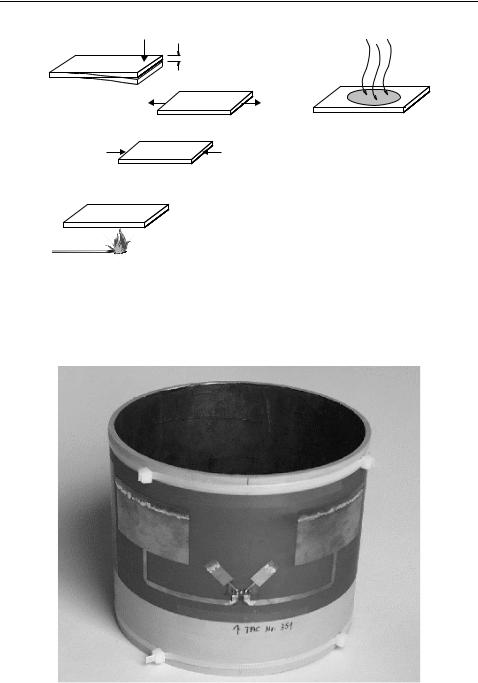
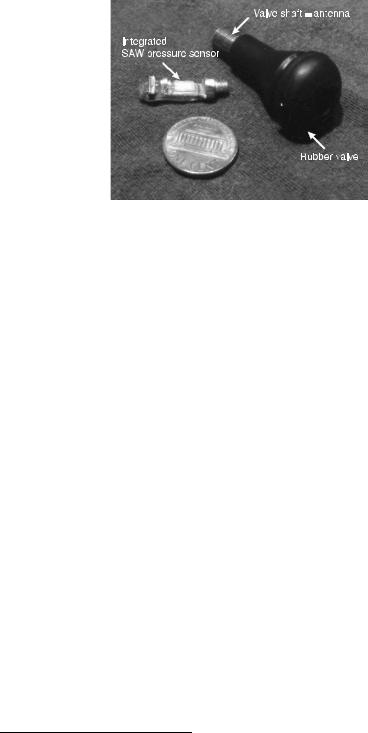
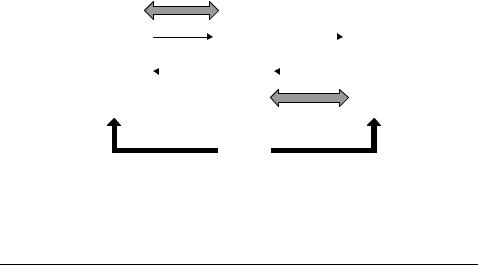
310 |
|
|
|
|
|
|
|
|
11 READERS |
|
Master |
Slave |
|
|
|
|
|
||
|
|
Command |
|
|
Command |
|
|
||
|
Application |
Reader |
|
Trans- |
|||||
|
|
|
|
|
|
|
|||
|
|
|
|
|
|
|
|||
|
|
|
|
|
ponder |
|
|||
|
|
|
|
|
|
|
|
|
|
|
|
|
|
|
|
|
|
|
|
|
|
Response |
|
|
Response |
|
|
||
|
|
Master |
|
Slave |
|||||
|
|
|
|
|
|
|
|||
Data flow
Figure 11.1 Master–slave principle between application software (application), reader and transponder
Table 11.1 Example of the execution of a read command by the application software, reader and transponder
Application ↔ reader |
Reader ↔ transponder |
Comment |
→ Blockread−Address[00] |
|
Read transponder memory |
|
→ Request |
[address] |
|
Transponder in the field? |
|
|
← ATR−SNR[4712] |
Transponder operates with |
|
→ GET−Random |
serial number |
|
Initiate authentication |
|
|
← Random[081514] |
|
|
→ SEND−Token1 |
|
|
← GET−Token2 |
Authentication successfully |
|
→ Read− @[00] |
completed |
|
Read command [address] |
|
← Data[9876543210] |
← Data[9876543210] |
Data from transponder |
|
Data to application |
(inductive — electromagnetic), the communication sequence (FDX, HDX, SEQ), the data transmission procedure from the transponder to the reader (load modulation, backscatter, subharmonic) and, last but not least, the frequency range, all readers are similar in their basic operating principle and thus in their design.
Readers in all systems can be reduced to two fundamental functional blocks: the control system and the HF interface, consisting of a transmitter and receiver (Figure 11.2). Figure 11.3 shows a reader for an inductively coupled RFID system. On the right-hand side we can see the HF interface, which is shielded against undesired spurious emissions by a tinplate housing. The control system is located on the left-hand side of the reader and, in this case, it comprises an ASIC module and microcontroller. In order that it can be integrated into a software application, this reader has an RS232 interface to perform the data exchange between the reader (slave) and the external application software (master).
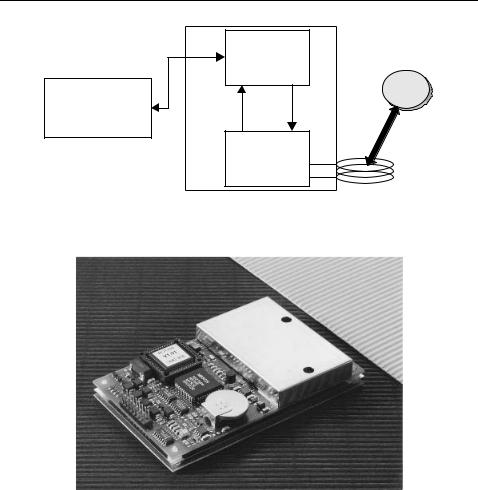
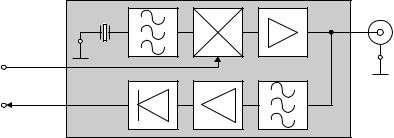
312 |
11 READERS |
Quarz |
Oscillator |
Modulator |
Output |
Antenna box |
|
|
|
module |
|
Transmission |
|
|
|
|
data |
|
|
|
|
|
|
|
/ |
|
Received |
|
|
/ |
|
data |
|
|
|
|
|
|
|
|
|
Demodulator |
Amplifier |
Bandpass filter |
|
|
Figure 11.4 Block diagram of an HF interface for an inductively coupled RFID system
the transponder travels through the transmitter arm. Conversely, data received from the transponder is processed in the receiver arm. We will now analyse the two signal channels in more detail, giving consideration to the differences between the different systems.
11.2.1.1Inductively coupled system, FDX/HDX
First, a signal of the required operating frequency, i.e. 135 kHz or 13.56 MHz, is generated in the transmitter arm by a stable (frequency) quartz oscillator. To avoid worsening the noise ratio in relation to the extremely weak received signal from the transponder, the oscillator is subject to high demands regarding phase stability and sideband noise.
The oscillator signal is fed into a modulation module controlled by the baseband signal of the signal coding system. This baseband signal is a keyed direct voltage signal (TTL level), in which the binary data is represented using a serial code (Manchester, Miller, NRZ). Depending upon the modulator type, ASK or PSK modulation is performed on the oscillator signal.
FSK modulation is also possible, in which case the baseband signal is fed directly into the frequency synthesiser.
The modulated signal is then brought to the required level by a power output module and can then be decoupled to the antenna box.
The receiver arm begins at the antenna box, with the first component being a steep edge bandpass filter or a notch filter. In FDX/HDX systems this filter has the task of largely blocking the strong signal from the transmission output module and filtering out just the response signal from the transponder. In subharmonic systems, this is a simple process, because transmission and reception frequencies are usually a whole octave apart. In systems with load modulation using a subcarrier the task of developing a suitable filter should not be underestimated because, in this case, the transmitted and received signals are only separated by the subcarrier frequency. Typical subcarrier frequencies in 13.56 MHz systems are 847 kHz or 212 kHz.
Some LF systems with load modulation and no subcarrier use a notch filter to increase the modulation depth (duty factor) — the ratio of the level to the load modulation sidebands — and thus the duty factor by reducing their own carrier signal.
